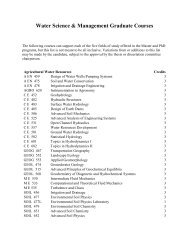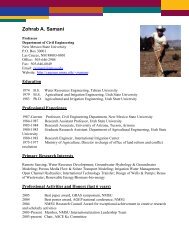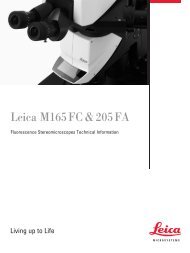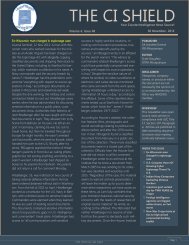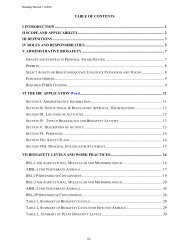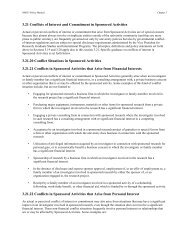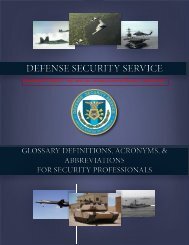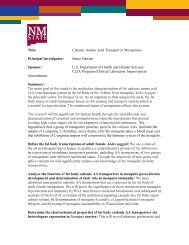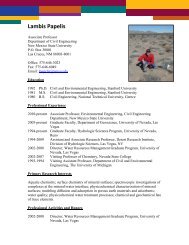classified marking guide (dec 2010) - the Security Training Portal.
classified marking guide (dec 2010) - the Security Training Portal.
classified marking guide (dec 2010) - the Security Training Portal.
You also want an ePaper? Increase the reach of your titles
YUMPU automatically turns print PDFs into web optimized ePapers that Google loves.
As required by Executive Order 13526, Classified National <strong>Security</strong> Information,December 29, 2009,and32 C.F.R. Part 2001, ISOO Implementing Directive, effective June 25, <strong>2010</strong>
This page left blank.
Introduction 2Reminders 2SECTION 1 – Originally Classified Documents 3Portion Marking 5Overall Classification Marking 6Classification Authority Block“Classified By” line 7“Reason” for classification line 8“Declassify On” line 9SECTION 2 – Derivatively Classified Documents 10Portion Marking 11Overall Classification Marking 12Classification Authority Block“Classified By” line 13“Derived From” line 14“Declassify On” line 16Declassification InstructionsMissing Declassification Instruction 17Multiple Sources 18OADR 20X1, X2, X3, X4, X5, X6, X7, and X8 21MR 22DNI Only/DCI Only 23Subject to Treaty or International Agreement 2425X1-human Exemption 25Use of 25X1 through 25X9 Exemptions 26Use of 50X and 75X Exemptions 26Derivatively Classifying from a Classification Guide 27SECTION 3 – Additional or Special Markings 29Classification Extensions 29Classification by Compilation 30Foreign Government Information 32Commingling RD and FRD with Information Classified 33under <strong>the</strong> OrderTransmittal Document 34SECTION 4 – Examples 35Summary of Changes From October 2007 Marking Book 42- 1 -
IntroductionExecutive Order (E.O.) 13526 and its implementing directive, 32 C.F.R Part 2001, prescribe a uniformsecurity classification system. This system requires that standard <strong>marking</strong>s be applied to <strong>classified</strong>information. Except in extraordinary circumstances, or as approved by <strong>the</strong> Director of <strong>the</strong> Information<strong>Security</strong> Oversight Office (ISOO), <strong>the</strong> <strong>marking</strong> of <strong>classified</strong> information shall not deviate from <strong>the</strong> prescribedformats. Markings shall be uniformly and conspicuously applied to leave no doubt about <strong>the</strong> <strong>classified</strong> statusof <strong>the</strong> information, <strong>the</strong> level of protection required, and <strong>the</strong> duration of classification. Since a booklet of thissize cannot illustrate every conceivable situation, please refer to <strong>the</strong> implementing directive, o<strong>the</strong>r ISOOissuances, and any instructions issued by your organization for fur<strong>the</strong>r clarification. Consult your securitymanager if you have any questions.This booklet is un<strong>classified</strong>, and as it is in <strong>the</strong> public domain, it may be reproduced without permission. Allclassification <strong>marking</strong>s used are for illustration purposes only. All previous booklets and <strong>the</strong> guidancecontained in <strong>the</strong>m are rescinded.Reminders Only individuals specifically authorized in writing may classify documents originally. Only individuals with <strong>the</strong> appropriate security clearance, who are required by <strong>the</strong>ir work to restate<strong>classified</strong> source information, may derivatively classify information. The terms “Top Secret,” “Secret,” and “Confidential” are not to be used to mark executive branchinformation that has not been properly designated as <strong>classified</strong> national security information underE.O. 13526. Information shall not be <strong>classified</strong> for any reason unrelated to <strong>the</strong> protection of <strong>the</strong> national security. Classifiers and authorized holders are responsible for ensuring that information is appropriately <strong>classified</strong>and properly marked. Individuals who believe that information in <strong>the</strong>ir possession is inappropriately <strong>classified</strong>, or inappropriatelyun<strong>classified</strong>, are expected to bring <strong>the</strong>ir concerns to <strong>the</strong> attention of responsible officials. The following <strong>marking</strong>s are not authorized in <strong>the</strong> “Declassify On” line:• “Originating Agency’s Determination Required” or “OADR” for documents created afterOctober 14, 1995;• “X1,” “X2,” “X3,” “X4,” “X5,” “X6,” “X7,” or “X8” for documents created afterSeptember 22, 2003;• “Manual Review” or “MR;”• “DNI Only” or “DCI Only;” and• “Subject to treaty or international agreement.” The “25X1-human” <strong>marking</strong> may be used only when a derivative classifier is carrying it forward from asource document.- 2 -
Section 1: Originally Classified DocumentsThe following is an example of a document that an original classifier has determined requiresprotection under E.O. 13526. It contains <strong>the</strong> primary <strong>marking</strong>s required under <strong>the</strong> Order, including: Portion <strong>marking</strong>s; Overall classification <strong>marking</strong>s; and Classification authority block consisting of:• A “Classified By” line to include <strong>the</strong> identity, by name and position, or by personalidentifier of <strong>the</strong> original classifier, and if not o<strong>the</strong>rwise evident, <strong>the</strong> agency and office oforigin.• The “Reason” for classification as provided in section 1.4 of <strong>the</strong> Order.• A “Declassify On” line which shall indicate one of <strong>the</strong> following durations of classification: A date or event for <strong>dec</strong>lassification that corresponds to <strong>the</strong> lapse of <strong>the</strong>information’s national security sensitivity, which is equal to or less than 10 yearsfrom <strong>the</strong> date of <strong>the</strong> original <strong>dec</strong>ision. A date not to exceed 25 years from <strong>the</strong> date of <strong>the</strong> original <strong>dec</strong>ision. If <strong>the</strong> <strong>classified</strong> information should clearly and demonstrably be expected to reveal<strong>the</strong> identity of a confidential human source or a human intelligence source, no dateor event shall be annotated and <strong>the</strong> <strong>marking</strong> “50X1-HUM” shall be used. If <strong>the</strong> <strong>classified</strong> information should clearly and demonstrably be expected to revealkey design concepts of weapons of mass destruction, no date or event shall beannotated and <strong>the</strong> <strong>marking</strong> “50X2-WMD” shall be used.NOTE: Ensure <strong>the</strong> document you create is dated. Having <strong>the</strong> correctdate of origin of <strong>the</strong> document may be critical when creating o<strong>the</strong>rdocuments using your originally <strong>classified</strong> document as a source.- 3 -
Department of Good WorksWashington, D.C. 20006Document before <strong>the</strong><strong>marking</strong>s are applied.June 27, <strong>2010</strong>MEMORANDUM FOR THE DIRECTORFrom: John E. Doe, Chief Division 5Subject: Examples1. Paragraph 1 contains “Un<strong>classified</strong>” information.Therefore, this portion will be marked with <strong>the</strong>designation “U” in paren<strong>the</strong>ses preceding <strong>the</strong> portion.2. Paragraph 2 contains “Secret” information. Therefore,this portion will be marked with <strong>the</strong> designation “S” inparen<strong>the</strong>ses preceding <strong>the</strong> portion.3. Paragraph 3 contains “Confidential” information.Therefore, this portion will be marked with <strong>the</strong>designation “C” in paren<strong>the</strong>ses preceding <strong>the</strong> portion.Document after <strong>the</strong><strong>marking</strong>s are applied.SECRETDepartment of Good WorksWashington, D.C. 20006June 27, <strong>2010</strong>MEMORANDUM FOR THE DIRECTORFrom: John E. Doe, Chief Division 5Subject: (U) Examples1. (U) Paragraph 1 contains “Un<strong>classified</strong>” information.Therefore, this portion will be marked with <strong>the</strong>designation “U” in paren<strong>the</strong>ses preceding <strong>the</strong> portion.NOTE: The date for <strong>dec</strong>lassificationmay be displayed ei<strong>the</strong>r by spellingout <strong>the</strong> month (June 27, 2015), ornumerically (20150627). Whendisplayed numerically, <strong>the</strong> followingformat must be used: YYYYMMDD.2. (S) Paragraph 2 contains “Secret” information.Therefore, this portion will be marked with <strong>the</strong>designation “S” in paren<strong>the</strong>ses preceding <strong>the</strong> portion.3. (C) Paragraph 3 contains “Confidential” information.Therefore, this portion will be marked with <strong>the</strong>designation “C” in paren<strong>the</strong>ses preceding <strong>the</strong> portion.Classified By: John E. Doe, Chief Division 5Reason: 1.4(a)Declassify On: 20150627SECRET- 4 -
Step 1 – Portion <strong>marking</strong> Identify <strong>the</strong> classification level of each portion.• A portion is ordinarily defined as a paragraph, but also includes subjects, titles, graphics,tables, charts, bullet statements, sub-paragraphs, <strong>classified</strong> signature blocks, bullets ando<strong>the</strong>r portions within slide presentations, and <strong>the</strong> like.• Portion <strong>marking</strong>s consist of <strong>the</strong> letters “(U)” for Un<strong>classified</strong>, “(C)” for Confidential,“(S)” for Secret, and “(TS)” for Top Secret.• The two paragraphs of this sample document contain “Secret” and “Un<strong>classified</strong>”information, respectively.• The abbreviations, in paren<strong>the</strong>ses, are placed before <strong>the</strong> portion to which <strong>the</strong>y apply.Portion mark as illustrated in this example.Department of Good WorksWashington, D.C. 20006June 27, <strong>2010</strong>MEMORANDUM FOR THE DIRECTORFrom: John E. Doe, Chief Division 5Subject: (U) Examples1. (U) Paragraph 1 contains “Un<strong>classified</strong>” information.Therefore, this portion will be marked with <strong>the</strong>designation “U” in paren<strong>the</strong>ses preceding <strong>the</strong> portion.• (S) If all sub-paragraphs are <strong>the</strong> same classificationas <strong>the</strong> primary paragraph, <strong>the</strong>n you do not need toportion mark <strong>the</strong> sub-paragraphs.• (U) However, if <strong>the</strong> portions are not all <strong>the</strong> sameclassification, <strong>the</strong>n all main and sub-paragraphs mustbe individually marked.2. (S) Paragraph 2 contains “Secret” information.Therefore, this portion will be marked with <strong>the</strong>designation “S” in paren<strong>the</strong>ses preceding <strong>the</strong> portion.NOTE: Portion <strong>marking</strong> waivers may be requested by an agency heador senior agency official. Such requests shall be submitted to <strong>the</strong>Director of ISOO. See 32 C.F.R. Part 2001.24(k) for more information.- 5 -
Step 2 – Overall classification <strong>marking</strong> Identify <strong>the</strong> overall classification of <strong>the</strong> document. This will be equal to <strong>the</strong> highestclassification level of any one portion found in <strong>the</strong> document. In this example, <strong>the</strong> highestclassification is “Secret,” found in paragraph 2.• Conspicuously place <strong>the</strong> overall classification at <strong>the</strong> top and bottom of <strong>the</strong> page.• If <strong>the</strong> document contains more than one page, place <strong>the</strong> overall <strong>marking</strong> at <strong>the</strong> top andbottom of <strong>the</strong> outside of <strong>the</strong> front cover, on <strong>the</strong> title page, on <strong>the</strong> first page, and on <strong>the</strong>outside of <strong>the</strong> back cover (if any).• Mark o<strong>the</strong>r internal pages ei<strong>the</strong>r with <strong>the</strong> overall classification or with a <strong>marking</strong>indicating <strong>the</strong> highest classification level of information contained on that page.SECRETDepartment of Good WorksWashington, D.C. 20006June 27, <strong>2010</strong>MEMORANDUM FOR THE DIRECTORFrom: John E. Doe, Chief Division 5Subject: (U) Examples1. (U) Paragraph 1 contains “Un<strong>classified</strong>” information.Therefore, this portion will be marked with <strong>the</strong>designation “U” in paren<strong>the</strong>ses preceding <strong>the</strong> portion.2. (S) Paragraph 2 contains “Secret” information.Therefore, this portion will be marked with <strong>the</strong>designation “S” in paren<strong>the</strong>ses preceding <strong>the</strong> portion.3. (C) Paragraph 3 contains “Confidential” information.Therefore, this portion will be marked with <strong>the</strong>designation “C” in paren<strong>the</strong>ses preceding <strong>the</strong> portion.SECRETNOTE: Some agencies require additional dissemination and control<strong>marking</strong>s that accompany <strong>the</strong> overall classification <strong>marking</strong>s.Contact your security manager for agency-specific <strong>guide</strong>lines.- 6 -
Step 3 – Classification authority block: “Classified By” line Identify <strong>the</strong> original classification authority (OCA) by name and position or personal identifier.• If <strong>the</strong> identity of <strong>the</strong> originating agency or office is not apparent on <strong>the</strong> face of <strong>the</strong>document, place it immediately following <strong>the</strong> name and position or personal identifierprovided in <strong>the</strong> “Classified By” line.SECRETDepartment of Good WorksWashington, D.C. 20006June 27, <strong>2010</strong>MEMORANDUM FOR THE DIRECTORFrom: John E. Doe, Chief Division 5Subject: (U) Examples1. (U) Paragraph 1 contains “Un<strong>classified</strong>” information.Therefore, this portion will be marked with <strong>the</strong>designation “U” in paren<strong>the</strong>ses preceding <strong>the</strong> portion.2. (S) Paragraph 2 contains “Secret” information.Therefore, this portion will be marked with <strong>the</strong>designation “S” in paren<strong>the</strong>ses preceding <strong>the</strong> portion.June 27, <strong>2010</strong>3. (C) Paragraph 3 contains “Confidential” information.MEMORANDUM FOR THE DIRECTORTherefore, this portion will be marked with <strong>the</strong>designation “C” in paren<strong>the</strong>ses preceding <strong>the</strong> portion.From: John E. Doe, Chief Division 5Classified By: John E. Doe, Chief Division 5Subject: (U) ExamplesSECRETSECRETDepartment of Good WorksWashington, D.C. 200061. (U) Paragraph 1 contains “Un<strong>classified</strong>” information.Therefore, this portion will be marked with <strong>the</strong>designation “U” in paren<strong>the</strong>ses preceding <strong>the</strong> portion.OCA by name and positionOCA by personal identifier2. (S) Paragraph 2 contains “Secret” information.Therefore, this portion will be marked with <strong>the</strong>designation “S” in paren<strong>the</strong>ses preceding <strong>the</strong> portion.3. (C) Paragraph 3 contains “Confidential” information.Therefore, this portion will be marked with <strong>the</strong>designation “C” in paren<strong>the</strong>ses preceding <strong>the</strong> portion.Classified By: ID # 54632- 7 -SECRET
Step 4 – Classification authority block: “Reason” for classificationline Place <strong>the</strong> number 1.4 plus <strong>the</strong> letter(s) that correspond(s) to <strong>the</strong> classification category in section1.4 of E.O. 13526. These categories, as <strong>the</strong>y appear in <strong>the</strong> Order, include <strong>the</strong> following:(a) military plans, weapons systems, oroperations;(b) foreign government information;(c) intelligence activities (including covertaction), intelligence sources or methods,or cryptology;(d) foreign relations or foreign activities of<strong>the</strong> United States, including confidentialsources;(e) scientific, technological, or economicmatters relating to <strong>the</strong> national security;(f) United States Government programs forsafeguarding nuclear materials or facilities;(g) vulnerabilities or capabilities of systems,installations, infrastructures, projects,plans, or protection services relating to<strong>the</strong> national security; or(h) <strong>the</strong> development, production, or use ofweapons of mass destruction.June 27, <strong>2010</strong>Department of Good WorksWashington, D.C. 20006MEMORANDUM FOR THE DIRECTORFrom: John E. Doe, Chief Division 5Subject: (U) ExamplesSECRET1. (U) Paragraph 1 contains “Un<strong>classified</strong>” information.Therefore, this portion will be marked with <strong>the</strong>designation “U” in paren<strong>the</strong>ses preceding <strong>the</strong> portion.2. (S) Paragraph 2 contains “Secret” information.Therefore, this portion will be marked with <strong>the</strong>designation “S” in paren<strong>the</strong>ses preceding <strong>the</strong> portion.3. (C) Paragraph 3 contains “Confidential” information.Therefore, this portion will be marked with <strong>the</strong>designation “C” in paren<strong>the</strong>ses preceding <strong>the</strong> portion.Classified By: John E. Doe, Chief Division 5Reason: 1.4(c)SECRET- 8 -
Step 5 – Classification authority block: “Declassify On” line This indicates <strong>the</strong> duration of classification. An original classifier must choose one of <strong>the</strong>following <strong>dec</strong>lassification instructions, selecting whenever possible, <strong>the</strong> <strong>dec</strong>lassificationinstruction that will result in <strong>the</strong> shortest duration of classification. A date or event that is less than 10 years from <strong>the</strong> date of original classification (date ofdocument is July 1, <strong>2010</strong>)Classified By: John E. Doe, Chief Division 5Reason: 1.4(a)Declassify On: 20150701A date that is 10 years from <strong>the</strong> date of <strong>the</strong> original classification <strong>dec</strong>ision (date of documentis July 1, <strong>2010</strong>)Classified By: John E. Doe, Chief Division 5Reason: 1.4(a)Declassify On: 20200701A date not to exceed 25 years from <strong>the</strong> date of <strong>the</strong> original classification <strong>dec</strong>ision (date ofdocument is July 1, <strong>2010</strong>). Exceptions to this sequence:Classified By: John E. Doe, Chief Division 5Reason: 1.4(a)Declassify On: 20350701 If <strong>the</strong> information should clearly and demonstrably be expected to reveal <strong>the</strong> identity of aconfidential human source or a human intelligence source, <strong>the</strong> duration of classification shall beup to 75 years and shall be designated as 50X1-HUM.Classified By: John E. Doe, Chief Division 5Reason: 1.4(c)Declassify On: 50X1-HUM If <strong>the</strong> information should clearly and demonstrably be expected to reveal key designconcepts of weapons of mass destruction, <strong>the</strong> duration shall be up to 75 years and shallbe designated as 50X2-WMD.Classified By: John E. Doe, Chief Division 5Reason: 1.4(h)Declassify On: 50X2-WMDNOTE: When 50X1-HUM and 50X2-WMD are used, a specific date or event for <strong>dec</strong>lassificationof <strong>the</strong> information will not be used. Approval by <strong>the</strong> ISCAP is not required prior to agency use of50X1-HUM or 50X2-WMD; however, it will need to be included in a classification <strong>guide</strong> withsufficient detail to enable effective use.- 9 -
Section 2: Derivatively Classified DocumentsDerivative classification is <strong>the</strong> act of incorporating, paraphrasing, restating, or generating in new forminformation that is already <strong>classified</strong>, and <strong>marking</strong> <strong>the</strong> newly developed material consistent with <strong>the</strong><strong>marking</strong>s of <strong>the</strong> source information. The source information ordinarily consists of a <strong>classified</strong>document or documents, or a classification <strong>guide</strong> issued by an original classification authority.When using a <strong>classified</strong> source document as <strong>the</strong> basis for derivative classification, <strong>the</strong> <strong>marking</strong>s on <strong>the</strong>source document determine <strong>the</strong> <strong>marking</strong>s to be applied to <strong>the</strong> derivative document. When using aclassification <strong>guide</strong> as <strong>the</strong> basis for derivative classification, <strong>the</strong> instructions provided by <strong>the</strong> <strong>guide</strong> areto be applied to <strong>the</strong> derivative document.The following examples are of a properly marked source document and a properly marked derivativedocument, followed by <strong>the</strong> steps taken to create <strong>the</strong> derivative document.Source DocumentJune 27, <strong>2010</strong>Department of Good WorksWashington, D.C. 20006MEMORANDUM FOR THE DIRECTORFrom: John E. Doe, Chief Division 5Subject: (U) ExamplesSECRET1. (U) Paragraph 1 contains un<strong>classified</strong> information.Therefore, this portion will be marked with <strong>the</strong>designation “U” in paren<strong>the</strong>ses preceding <strong>the</strong> portion.2. (S) Paragraph 2 contains “Secret” information.Therefore, this portion will be marked with <strong>the</strong>designation “S” in paren<strong>the</strong>ses preceding <strong>the</strong> portion.3. (C) Paragraph 3 contains “Confidential” information.Therefore, this portion will be marked with <strong>the</strong>designation “C” in paren<strong>the</strong>ses preceding <strong>the</strong> portion.Classified By: John E. Doe, Chief Division 5Reason: 1.4(a)Declassify On: 20151231SECRETJuly 15, <strong>2010</strong>Department of InformationWashington, D.C. 20008MEMORANDUM FOR AGENCY OFFICIALSFrom: Joe Carver, DirectorSubject: (U) ExamplesDerivative DocumentSECRET1. (S) Paragraph 1 contains information from Paragraph 2in <strong>the</strong> source document and is <strong>the</strong>refore marked (S).2. (U) Paragraph 2 contains “Un<strong>classified</strong>” information.Therefore, this portion will be marked with <strong>the</strong>designation “U” in paren<strong>the</strong>ses preceding <strong>the</strong> portion.Classified By: Joe Carver, DirectorDerived From: Department of Good Works Memorandumdated June 27, <strong>2010</strong>, Subj: (U) ExamplesDeclassify On: 20151231SECRET- 10 -
Source DocumentJune 27, <strong>2010</strong>SECRETDepartment of Good WorksWashington, D.C. 20006MEMORANDUM FOR THE DIRECTORFrom: John E. Doe, Chief Division 5Step 1 - Portion <strong>marking</strong>Paragraph 1 of <strong>the</strong> derivativedocument incorporates informationfrom paragraph 2 of <strong>the</strong> sourcedocument. Therefore, <strong>the</strong> portion<strong>marking</strong> is carried over to <strong>the</strong>derivative document.Subject: (U) Examples1. (U) Paragraph 1 contains “Un<strong>classified</strong>” information.Therefore, this portion will be marked with <strong>the</strong>designation “U” in paren<strong>the</strong>ses preceding <strong>the</strong> portion.2. (S) Paragraph 2 contains “Secret” information.Therefore, this portion will be marked with <strong>the</strong>designation “S” in paren<strong>the</strong>ses preceding <strong>the</strong> portion.Derivative Document3. (C) Paragraph 3 contains “Confidential” information.Therefore, this portion will be marked with <strong>the</strong>designation “C” in paren<strong>the</strong>ses preceding <strong>the</strong> portion.Classified By: John E. Doe, Chief Division 5Reason: 1.4(a)Declassify On: 20151231SECRETJuly 15, <strong>2010</strong>Department of InformationWashington, D.C. 20008MEMORANDUM FOR AGENCY OFFICIALSFrom: Joe Carver, DirectorSubject: (U) Examples1. (S) Paragraph 1 contains information from Paragraph 2in <strong>the</strong> source document and is <strong>the</strong>refore marked (S).2. (U) Paragraph 2 contains “Un<strong>classified</strong>” information.Therefore, this portion will be marked with <strong>the</strong>designation “U” in paren<strong>the</strong>ses preceding <strong>the</strong> portion.- 11 -
Source DocumentJune 27, <strong>2010</strong>Department of Good WorksWashington, D.C. 20006MEMORANDUM FOR THE DIRECTORFrom: John E. Doe, Chief Division 5Subject: (U) ExamplesSECRETStep 2 - Overallclassification <strong>marking</strong>The highest level of any portion of thisderivative document is “Secret.”Therefore, conspicuously place an overallclassification of “SECRET” at <strong>the</strong> topand bottom of <strong>the</strong> derivative document.1. (U) Paragraph 1 contains “Un<strong>classified</strong>” information.Therefore, this portion will be marked with <strong>the</strong>designation “U” in paren<strong>the</strong>ses preceding <strong>the</strong> portion.2. (S) Paragraph 2 contains “Secret” information.Therefore, this portion will be marked with <strong>the</strong>designation “S” in paren<strong>the</strong>ses preceding <strong>the</strong> portion.Derivative Document3. (C) Paragraph 3 contains “Confidential” information.Therefore, this portion will be marked with <strong>the</strong>designation “C” in paren<strong>the</strong>ses preceding <strong>the</strong> portion.Classified By: John E. Doe, Chief Division 5Reason: 1.4(a)Declassify On: 20151231SECRETJuly 15, <strong>2010</strong>Department of InformationWashington, D.C. 20008MEMORANDUM FOR AGENCY OFFICIALSFrom: Joe Carver, DirectorSubject: (U) ExamplesSECRET1. (S) Paragraph 1 contains information from Paragraph 2in <strong>the</strong> source document and is <strong>the</strong>refore marked (S).2. (U) Paragraph 2 contains “Un<strong>classified</strong>” information.Therefore, this portion will be marked with <strong>the</strong>designation “U” in paren<strong>the</strong>ses preceding <strong>the</strong> portion.SECRET- 12 -
Source DocumentJune 27, <strong>2010</strong>Department of Good WorksWashington, D.C. 20006MEMORANDUM FOR THE DIRECTORFrom: John E. Doe, Chief Division 5Subject: (U) ExamplesSECRETStep 3 – Classificationauthority block: “ClassifiedBy” lineDerivative classifiers shall be identified byname and position, or by personalidentifier, in a manner that is immediatelyapparent on each derivatively <strong>classified</strong>document.1. (U) Paragraph 1 contains “Un<strong>classified</strong>” information.Therefore, this portion will be marked with <strong>the</strong>designation “U” in paren<strong>the</strong>ses preceding <strong>the</strong> portion.2. (S) Paragraph 2 contains “Secret” information.Therefore, this portion will be marked with <strong>the</strong>designation “S” in paren<strong>the</strong>ses preceding <strong>the</strong> portion.Derivative Document3. (C) Paragraph 3 contains “Confidential” information.Therefore, this portion will be marked with <strong>the</strong>designation “C” in paren<strong>the</strong>ses preceding <strong>the</strong> portion.Classified By: John E. Doe, Chief Division 5Reason: 1.4(a)Declassify On: 20151231SECRETJuly 15, <strong>2010</strong>Department of InformationWashington, D.C. 20008MEMORANDUM FOR AGENCY OFFICIALSFrom: Joe Carver, DirectorSubject: (U) ExamplesSECRETNOTE: If not o<strong>the</strong>rwise evident, <strong>the</strong>agency and office of origin shall beidentified and placed immediatelyfollowing <strong>the</strong> name and position orpersonal identifier provided in <strong>the</strong>“Classified By” line.1. (S) Paragraph 1 contains information from Paragraph 2in <strong>the</strong> source document and is <strong>the</strong>refore marked (S).2. (U) Paragraph 2 contains “Un<strong>classified</strong>” information.Therefore, this portion will be marked with <strong>the</strong>designation “U” in paren<strong>the</strong>ses preceding <strong>the</strong> portion.Classified By: Joe Carver, DirectorSECRET- 13 -
Source DocumentJune 27, <strong>2010</strong>Department of Good WorksWashington, D.C. 20006MEMORANDUM FOR THE DIRECTORFrom: John E. Doe, Chief Division 5Subject: (U) ExamplesSECRETStep 4 – Classificationauthority block: “DerivedFrom” lineConcisely identify <strong>the</strong> source document or<strong>the</strong> classification <strong>guide</strong> on <strong>the</strong> ‘‘DerivedFrom’’ line, including <strong>the</strong> agency and,where available, <strong>the</strong> office of origin, and<strong>the</strong> date of <strong>the</strong> source or <strong>guide</strong>.1. (U) Paragraph 1 contains “Un<strong>classified</strong>” information.Therefore, this portion will be marked with <strong>the</strong>designation “U” in paren<strong>the</strong>ses preceding <strong>the</strong> portion.2. (S) Paragraph 2 contains “Secret” information.Therefore, this portion will be marked with <strong>the</strong>designation “S” in paren<strong>the</strong>ses preceding <strong>the</strong> portion.3. (C) Paragraph 3 contains “Confidential” information.Therefore, this portion will be marked with <strong>the</strong>designation “C” in paren<strong>the</strong>ses preceding <strong>the</strong> portion.Classified By: John E. Doe, Chief Division 5Reason: 1.4(a)Declassify On: 20151231SECRETJuly 15, <strong>2010</strong>Derivative DocumentSECRETDepartment of InformationWashington, D.C. 20008MEMORANDUM FOR AGENCY OFFICIALSFrom: Joe Carver, DirectorSubject: (U) Examples1. (S) Paragraph 1 contains information from Paragraph 2in <strong>the</strong> source document and is <strong>the</strong>refore marked (S).2. (U) Paragraph 2 contains “Un<strong>classified</strong>” information.Therefore, this portion will be marked with <strong>the</strong>designation “U” in paren<strong>the</strong>ses preceding <strong>the</strong> portion.Classified By: Joe Carver, DirectorDerived From: Department of Good WorksMemorandum dated June 27, <strong>2010</strong>, Subj: (U) ExamplesSECRET- 14 -
Step 4 - “Derived From” line, cont’dWhen using multiple source documents, <strong>the</strong> “Derived From” line shall appear as:Derived From: Multiple SourcesThe derivative classifier shall include a listing of<strong>the</strong> source materials on, or attached to, eachderivatively <strong>classified</strong> document. There is norequired placement of <strong>the</strong> source list within <strong>the</strong>document, only that it be included in, or attachedto, <strong>the</strong> document.Sources:1. Dept of Good Works Memorandumdated June 27, <strong>2010</strong>, Subj: Examples2. Dept of Good Works Memorandumdated May 30, 2009, Subj: Examples3. Radar SCG dated February 2, 2006A document derivatively <strong>classified</strong> on <strong>the</strong> basis of a source document that is itself marked“Multiple Sources” shall cite <strong>the</strong> source document on its “Derived From” line ra<strong>the</strong>r than <strong>the</strong>term “Multiple Sources.” An example might appear as:Source DocumentSECRETDepartment of Good WorksWashington, D.C. 20006Derivative DocumentSECRETJune 27, <strong>2010</strong>MEMORANDUM FOR THE DIRECTORFrom: John E. Doe, Chief Division 5Subject: (U) Examples1. (U) Paragraph 1 contains “Un<strong>classified</strong>” information.Therefore, this portion will be marked with <strong>the</strong>designation “U” in paren<strong>the</strong>ses preceding <strong>the</strong> portion.2. (S) Paragraph 2 contains “Secret” information.Therefore, this portion will be marked with <strong>the</strong>designation “S” in paren<strong>the</strong>ses preceding <strong>the</strong> portion.Classified By: John E. Doe, Chief Division 5Derived From: Multiple SourcesDeclassify On: 20200627SECRETJuly 15, <strong>2010</strong>Department of InformationWashington, D.C. 20008MEMORANDUM FOR AGENCY OFFICIALSFrom: Joe Carver, DirectorSubject: (U) Examples1. (S) Paragraph 1 contains information from Paragraph 2in <strong>the</strong> source document and is <strong>the</strong>refore marked (S).2. (U) Paragraph 2 contains “Un<strong>classified</strong>” information.Therefore, this portion will be marked with <strong>the</strong>designation “U” in paren<strong>the</strong>ses preceding <strong>the</strong> portion.Classified By: Joe Carver, DirectorDerived From: Department of Good Works Memorandumdated June 27, <strong>2010</strong>, Subj: ExamplesDeclassify On: 20200627SECRET- 15 -
Source DocumentJune 27, <strong>2010</strong>Department of Good WorksWashington, D.C. 20006MEMORANDUM FOR THE DIRECTORFrom: John E. Doe, Chief Division 5Subject: (U) ExamplesSECRET1. (U) Paragraph 1 contains “Un<strong>classified</strong>” information.Therefore, this portion will be marked with <strong>the</strong>designation “U” in paren<strong>the</strong>ses preceding <strong>the</strong> portion.2. (S) Paragraph 2 contains “Secret” information.Therefore, this portion will be marked with <strong>the</strong>designation “S” in paren<strong>the</strong>ses preceding <strong>the</strong> portion.Step 5 – Classificationauthority block: “DeclassifyOn” lineThe derivative classifier shall carry forward<strong>the</strong> instructions on <strong>the</strong> ‘‘Declassify On’’ linefrom <strong>the</strong> source document to <strong>the</strong> derivativedocument, or <strong>the</strong> duration instruction from<strong>the</strong> classification or <strong>dec</strong>lassification <strong>guide</strong>.(See <strong>the</strong> following pages for additionalguidance when <strong>the</strong> source documentcontains missing, unauthorized, or multiple<strong>dec</strong>lassification instructions.)Derivative Document3. (C) Paragraph 3 contains “Confidential” information.Therefore, this portion will be marked with <strong>the</strong>designation “C” in paren<strong>the</strong>ses preceding <strong>the</strong> portion.Classified By: John E. Doe, Chief Division 5Reason: 1.4(a)Declassify On: 20150627SECRETJuly 15, <strong>2010</strong>Department of InformationWashington, D.C. 20008MEMORANDUM FOR AGENCY OFFICIALSFrom: Joe Carver, DirectorSubject: (U) ExamplesSECRET1. (S) Paragraph 1 contains information from Paragraph 2in <strong>the</strong> source document and is <strong>the</strong>refore marked (S).2. (U) Paragraph 2 contains “Un<strong>classified</strong>” information.Therefore, this portion will be marked with <strong>the</strong>designation “U” in paren<strong>the</strong>ses preceding <strong>the</strong> portion.Classified By: Joe Carver, DirectorDerived From: Department of Good Works Memorandumdated June 27, <strong>2010</strong>, Subj: (U) ExamplesDeclassify On: 20150627SECRET- 16 -
Declassification Instructions on Derivatively Classified Documents:If <strong>the</strong> source document is missing <strong>the</strong> <strong>dec</strong>lassification instruction, <strong>the</strong>n a calculated date of 25 yearsfrom <strong>the</strong> date of <strong>the</strong> source document (if available) or <strong>the</strong> current date (if <strong>the</strong> source document date isnot available) shall be carried forward by <strong>the</strong> derivative classifier.Source DocumentJune 27, <strong>2010</strong>Department of Good WorksWashington, D.C. 20006MEMORANDUM FOR THE DIRECTORFrom: John E. Doe, Chief Division 5Subject: (U) ExamplesSECRET1. (U) Paragraph 1 contains “Un<strong>classified</strong>” information.Therefore, this portion will be marked with <strong>the</strong>designation “U” in paren<strong>the</strong>ses.2. (S) Paragraph 2 contains “Secret” information.Therefore, this portion will be marked with <strong>the</strong>designation “S” in paren<strong>the</strong>ses.3. (C) Paragraph 3 contains “Confidential” information.Therefore, this portion will be marked with <strong>the</strong>designation “C” in paren<strong>the</strong>ses.Classified By: John E. Doe, Chief Division 5Reason: 1.4(a)SECRETDerivative DocumentClassified By: Joe Carver, DirectorDerived From: Department of Good WorksMemorandum dated June 27, <strong>2010</strong>, Subj: (U) ExamplesDeclassify on: 20350627SECRET- 17 -
Declassification Instructions on Derivatively Classified Documents:When a document is <strong>classified</strong> derivatively on <strong>the</strong> basis of more than one source document or morethan one element of a classification <strong>guide</strong>, <strong>the</strong> ‘‘Declassify On’’ line shall reflect <strong>the</strong> longest durationof classification of any of its sources.Source Document 1June 27, <strong>2010</strong>Department of Good WorksWashington, D.C. 20006MEMORANDUM FOR THE DIRECTORFrom: John E. Doe, Chief Division 5Subject: (U) ExamplesSECRET1. (U) Paragraph 1 contains “Un<strong>classified</strong>” information.Therefore, this portion will be marked with <strong>the</strong>designation “U” in paren<strong>the</strong>ses preceding <strong>the</strong> portion.2. (S) Paragraph 2 contains “Secret” information.Therefore, this portion will be marked with <strong>the</strong>designation “S” in paren<strong>the</strong>ses preceding <strong>the</strong> portion.Classified By: John E. Doe, Chief Division 5Reason: 1.4(a)Declassify On: 20151231SECRETOf <strong>the</strong> two <strong>dec</strong>lassification dates,20151231 and 20290530, <strong>the</strong> date fromsource document 2 has <strong>the</strong> longestduration of classification and will becarried forward to <strong>the</strong> derivativedocument.- 18 -Source Document 2May 30, 2009Department of Good WorksWashington, D.C. 20006MEMORANDUM FOR THE DIRECTORFrom: John E. Doe, Chief Division 5Subject: (U) ExamplesSECRET1. (U) Paragraph 1 contains “Un<strong>classified</strong>” information.Therefore, this portion will be marked with <strong>the</strong>designation “U” in paren<strong>the</strong>ses preceding <strong>the</strong> portion.2. (S) Paragraph 2 contains “Secret” information.Therefore, this portion will be marked with <strong>the</strong>designation “S” in paren<strong>the</strong>ses preceding <strong>the</strong> portion.Classified By: John E. Doe, Chief Division 5Reason: 1.4(a)Declassify On: 20290530SECRETClassified By: Joe Carver, DirectorDerived From: Multiple SourcesDeclassify On: 20290530SECRETDerivative Document
If <strong>the</strong> source documents contain multiple 25X <strong>marking</strong>s, only one of <strong>the</strong> <strong>marking</strong>s is requiredto be placed on <strong>the</strong> derivative document, as long as it is <strong>the</strong> one with <strong>the</strong> longest duration ofclassification. For example:Document 1 – 25X3, 20350215Document 2 – 25X5, 20320510Document 3 – 25X4, 20301220The <strong>marking</strong> from document 1 (25X3, 20350215) would be carried over to <strong>the</strong> derivativedocument and placed in <strong>the</strong> “Declassify On” line.When determining <strong>the</strong> most restrictive <strong>dec</strong>lassification instruction among multiple sourcedocuments for placement in <strong>the</strong> “Declassify On” line, adhere to <strong>the</strong> following hierarchy:1. “50X1-HUM” or “50X2-WMD” exemptions, oran approved exemption (“50X1” thru “50X9”)reflecting <strong>the</strong> ISCAP approval for classificationbeyond 50 years in accordance with section3.3(h)(2) of <strong>the</strong> Order.2. “25X1” through “25X9” exemptions, with a dateor event.3. A specific <strong>dec</strong>lassification date or event within25 years.4. Absent guidance from an original classificationauthority with jurisdiction over <strong>the</strong> information, acalculated 25-year date from <strong>the</strong> date of <strong>the</strong>source document.Reference: 32 C.F.R. Part 2001.22(e)(4)- 19 -
Declassification Instructions on Derivatively Classified Documents:When a document is <strong>classified</strong> derivatively ei<strong>the</strong>r from a source document(s) or a classification <strong>guide</strong>that contains one of <strong>the</strong> following obsolete <strong>dec</strong>lassification instructions, ‘‘Originating Agency’sDetermination Required,’’ ‘‘OADR,’’ or “Manual Review,” “MR,” or any of <strong>the</strong> exemption <strong>marking</strong>s“X1, X2, X3, X4, X5, X6, X7, and X8,” <strong>the</strong> derivative classifier shall calculate a date that is 25 yearsfrom <strong>the</strong> date of <strong>the</strong> source document when determining a derivative document’s date or event to beplaced in <strong>the</strong> “Declassify On” line.SECRETDepartment of Good WorksWashington, D.C. 20006Source DocumentFebruary 2, 1994MEMORANDUM FOR THE DIRECTORFrom: John E. Doe, Chief Division 5Subject: (U) ExamplesNOTE: Executive Order 12958,issued in 1995, eliminated <strong>the</strong> useof “OADR” on documents createdon or after October 14, 1995.1. (U) Paragraph 1 contains “Un<strong>classified</strong>” information.Therefore, this portion will be marked with <strong>the</strong>designation “U” in paren<strong>the</strong>ses preceding <strong>the</strong> portion.2. (S) Paragraph 2 contains “Secret” information.Therefore, this portion will be marked with <strong>the</strong>designation “S” in paren<strong>the</strong>ses preceding <strong>the</strong> portion.Classified By: John E. Doe, Chief Division 5Reason: 1.4(a)Declassify On: OADRSECRETDerivative DocumentDo not carry forward “OADR.”Change “OADR” to 25 years from<strong>the</strong> date of <strong>the</strong> source documentClassified By: Joe Carver, DirectorDerived From: Department of Good WorksMemorandum dated Feb 2, 1994Subj: (U) ExamplesDeclassify On: 20190202If <strong>the</strong> source document does not contain a date, <strong>the</strong>n <strong>the</strong> <strong>dec</strong>lassification date on <strong>the</strong> derivativedocument will be 25 years from <strong>the</strong> date of <strong>the</strong> derivative document’s creation.- 20 -
Declassification Instructions on Derivatively Classified Documents:When a document is <strong>classified</strong> derivatively ei<strong>the</strong>r from a source document(s) or a classification <strong>guide</strong>that contains one of <strong>the</strong> following obsolete <strong>dec</strong>lassification instructions, ‘‘Originating Agency’sDetermination Required,’’ ‘‘OADR,’’ or “Manual Review,” “MR,” or any of <strong>the</strong> exemption <strong>marking</strong>s“X1, X2, X3, X4, X5, X6, X7, and X8,” <strong>the</strong> derivative classifier shall calculate a date that is 25 yearsfrom <strong>the</strong> date of <strong>the</strong> source document when determining a derivative document’s date or event to beplaced in <strong>the</strong> “Declassify On” line.Source DocumentAugust 20, 2002SECRETDepartment of Good WorksWashington, D.C. 20006MEMORANDUM FOR THE DIRECTORFrom: John E. Doe, Chief Division 5Subject: (U) Examples1. (U) Paragraph 1 contains “Un<strong>classified</strong>” information.Therefore, this portion will be marked with <strong>the</strong>designation “U” in paren<strong>the</strong>ses preceding <strong>the</strong> portion.NOTE: Executive Order 12958,as amended, issued in 2003,eliminated <strong>the</strong> use of X1, X2, X3,X4, X5, X6, X7, and X8 ondocuments created on or afterSeptember 22, 2003.2. (S) Paragraph 2 contains “Secret” information.Therefore, this portion will be marked with <strong>the</strong>designation “S” in paren<strong>the</strong>ses preceding <strong>the</strong> portion.3. (C) Paragraph 3 contains “Confidential” information.Therefore, this portion will be marked with <strong>the</strong>designation “C” in paren<strong>the</strong>ses preceding <strong>the</strong> portion.Classified By: John E. Doe, Chief Division 5Reason: 1.4(a)Declassify on: X3SECRETDerivative DocumentDo not carry forward “X3.”Change “X3” to 25 years from <strong>the</strong>date of <strong>the</strong> source documentClassified By: Joe Carver, DirectorDerived From: Department of Good Works Memorandum datedAug 20, 2002, Subj: (U) ExamplesDeclassify On: 20270820SECRETIf <strong>the</strong> source document does not contain a date, <strong>the</strong>n <strong>the</strong> <strong>dec</strong>lassification date on <strong>the</strong> derivativedocument will be 25 years from <strong>the</strong> date of <strong>the</strong> derivative document’s creation.- 21 -
Declassification Instructions on Derivatively Classified Documents:When a document is <strong>classified</strong> derivatively ei<strong>the</strong>r from a source document(s) or a classification <strong>guide</strong>that contains one of <strong>the</strong> following obsolete <strong>dec</strong>lassification instructions, ‘‘Originating Agency’sDetermination Required,’’ ‘‘OADR,’’ or “Manual Review,” “MR,” or any of <strong>the</strong> exemption <strong>marking</strong>sX1, X2, X3, X4, X5, X6, X7, and X8, <strong>the</strong> derivative classifier shall calculate a date that is 25 yearsfrom <strong>the</strong> date of <strong>the</strong> source document when determining a derivative document’s date or event to beplaced in <strong>the</strong> “Declassify On” line.Source DocumentFebruary 15, 2004Department of Good WorksWashington, D.C. 20006MEMORANDUM FOR THE DIRECTORFrom: John E. Doe, Chief Division 5Subject: (U) ExamplesSECRETNOTE: “MR” (Manual Review) wasnei<strong>the</strong>r intended nor authorized as a<strong>marking</strong> for <strong>the</strong> “Declassify on” lineon documents <strong>classified</strong> under anyexecutive order. If “MR” appears in<strong>the</strong> “Declassify on” line of a sourcedocument, mark <strong>the</strong> derivativedocument with a <strong>dec</strong>lassification dateno more than 25 years from <strong>the</strong> dateof <strong>the</strong> source document.1. (U) Paragraph 1 contains “Un<strong>classified</strong>” information.Therefore, this portion will be marked with <strong>the</strong>designation “U” in paren<strong>the</strong>ses preceding <strong>the</strong> portion.2. (S) Paragraph 2 contains “Secret” information.Therefore, this portion will be marked with <strong>the</strong>designation “S” in paren<strong>the</strong>ses preceding <strong>the</strong> portion.3. (C) Paragraph 3 contains “Confidential” information.Therefore, this portion will be marked with <strong>the</strong>designation “C” in paren<strong>the</strong>ses preceding <strong>the</strong> portion.Classified By: John E. Doe, Chief Division 5Reason: 1.4(a)Declassify On: MRSECRETDerivative DocumentDo not carry forward “MR.”Change “MR” to 25 years from <strong>the</strong>date of <strong>the</strong> source documentClassified By: Joan Smith, Program AnalystDerived From: Department of Good Works Memorandumdated Feb 15, 2004, Subj: (U) ExamplesDeclassify On: 20290215SECRETIf <strong>the</strong> source document does not contain a date, <strong>the</strong>n <strong>the</strong> <strong>dec</strong>lassification date on <strong>the</strong> derivativedocument will be 25 years from <strong>the</strong> date of <strong>the</strong> derivative document’s creation.- 22 -
Declassification Instructions on Derivatively Classified Documents:When a source document contains <strong>the</strong> <strong>dec</strong>lassification instruction “DNI Only” or “DCI Only,” <strong>the</strong>derivative document will be marked as “Declassify On: 25X1, E.O. 12951.”Source DocumentSECRETFebruary 15, 2004Department of Good WorksWashington, D.C. 20006MEMORANDUM FOR THE DIRECTORFrom: John E. Doe, Chief Division 5Subject: (U) Examples1. (U) Paragraph 1 contains “Un<strong>classified</strong>” information.Therefore, this portion will be marked with <strong>the</strong>designation “U” in paren<strong>the</strong>ses preceding <strong>the</strong> portion.2. (S) Paragraph 2 contains “Secret” information.Therefore, this portion will be marked with <strong>the</strong>designation “S” in paren<strong>the</strong>ses preceding <strong>the</strong> portion.Classified By: John E. Doe, Chief Division 5Reason: 1.4(a)Declassify On: DNI OnlySECRETDerivative DocumentChange “DNI Only” or “DCI Only” to“25X1, E.O. 12951.”Classified By: Joan Smith, Program AnalystDerived From: Department of Good Works Memorandumdated Feb 15, 2004, Subj: (U) ExamplesDeclassify on: 25X1, E.O. 12951SECRETNOTE: E.O. 12951, Release of Imagery Acquired by Space-Based National IntelligenceReconnaissance Systems, gives <strong>the</strong> Director of National Intelligence (DNI) <strong>the</strong> authority to<strong>dec</strong>lassify intelligence imagery.- 23 -
Declassification Instructions on Derivatively Classified Documents:When creating a new, originally <strong>classified</strong> U.S. document containing FGI, <strong>the</strong> statement “Subjectto Treaty or International Agreement” is not to be used in <strong>the</strong> “Declassify On” line.Classified By: John E. Doe, Chief Division 5Derived From: Multiple SourcesDeclassify On: Subject to Treaty or International AgreementSECRETTHIS DOCUMENT CONTAINS (COUNTRYOF ORIGIN) INFORMATIONNOTE: Additional guidance on <strong>marking</strong> documentscontaining FGI can be found on page 32.If this <strong>marking</strong> still appears on a document being used as a source, <strong>the</strong> <strong>marking</strong> annotated on <strong>the</strong>derivative document will be changed to a date that is 25 years from <strong>the</strong> date of <strong>the</strong> sourcedocument. If <strong>the</strong> source document does not contain a date, <strong>the</strong>n <strong>the</strong> <strong>dec</strong>lassification date will be 25years from <strong>the</strong> date of <strong>the</strong> derivative document’s creation.Source DocumentMay 15, 2000Classified By: John E. Doe, Chief Division 5Derived From: Multiple SourcesDeclassify On: Subject to Treaty or InternationalAgreementSECRETTHIS DOCUMENT CONTAINS (COUNTRYOF ORIGIN) INFORMATIONDerivative DocumentChange “Subject to Treaty orInternational Agreement” to 25years from <strong>the</strong> date of <strong>the</strong> sourcedocumentJune 21, 2003Classified By: Joan Smith, Program AnalystDerived From: [Agency] Memorandum dated May 15, 2000Declassify On: May 15, 2025SECRETTHIS DOCUMENT CONTAINS (COUNTRYOF ORIGIN) INFORMATION- 24 -
Declassification Instructions on Derivatively Classified Documents:Source DocumentClassified By: Joe Carver, DirectorReason: 1.4(c)Declassify On: 25X1-humanSECRETDerivative DocumentCarry over <strong>the</strong> <strong>dec</strong>lassification instruction“25X1-human” from <strong>the</strong> source documentto <strong>the</strong> derivative document. Do notchange to “50X1-HUM” withoutauthorization from <strong>the</strong> originating agency.Classified By: Joan Smith, Program AnalystDerived From: Department of Good Works Memorandumdated June 27, <strong>2010</strong>, Subj: (U) ExamplesDeclassify On: 25X1-humanSECRET- 25 -
Declassification Instructions on Derivatively Classified Documents:Use of 25X1 through 25X9 ExemptionsThe 25X exemptions may only be used on<strong>the</strong> “Declassify On” line if an agency hasidentified permanently valuableinformation that needs to be exemptedfrom automatic <strong>dec</strong>lassification at 25years and has received approval from <strong>the</strong>Interagency <strong>Security</strong> ClassificationAppeals Panel (ISCAP) to exempt <strong>the</strong>information and to incorporate <strong>the</strong>exemption into a classification <strong>guide</strong>.(See 32 C.F.R. Part 2001.26.)When using an approved exemption, adate or event that has been approved by<strong>the</strong> ISCAP must be included with <strong>the</strong><strong>marking</strong> and shall not exceed50 years from <strong>the</strong> date of <strong>the</strong> document.February 15, 2004Department of Good WorksWashington, D.C. 20006MEMORANDUM FOR THE DIRECTORFrom: John E. Doe, Chief Division 5Subject: (U) ExamplesSECRET1. (U) Paragraph 1 contains “Un<strong>classified</strong>” information.Therefore, this portion will be marked with <strong>the</strong>designation “U” in paren<strong>the</strong>ses preceding <strong>the</strong> portion.2. (S) Paragraph 2 contains “Secret” information.Therefore, this portion will be marked with <strong>the</strong>designation “S” in paren<strong>the</strong>ses preceding <strong>the</strong> portion.Use of 50X and 75X ExemptionsClassified By: John E. Doe, Chief Division 5Derived From: SCG title and dateDeclassify On: 25X3, 20540215SECRETIn extraordinary cases, agency heads may,within five years of <strong>the</strong> onset of automatic<strong>dec</strong>lassification, propose to fur<strong>the</strong>r exemptspecific information from <strong>dec</strong>lassification at50 years and at 75 years. These are subject toapproval by <strong>the</strong> ISCAP.ISCAP-approved exemptions at 50 and 75years will include a date or event that hasbeen approved by <strong>the</strong> ISCAP.Classified By: John E. Doe, Chief Division 5Derived From: SCG title and dateDeclassify On: 50X4, 20750215Classified By: John E. Doe, Chief Division 5Derived From: SCG title and dateDeclassify On: 75X5, 20901231- 26 -
Derivatively Classifying from a Classification GuideA classification <strong>guide</strong> is a document issued by an OCA that provides derivative classificationinstructions. It describes <strong>the</strong> elements of information that must be protected, <strong>the</strong> reason forclassification, and <strong>the</strong> level and duration of classification. The examples on <strong>the</strong> next page showhow to apply instructions from <strong>the</strong> classification <strong>guide</strong> to a document.DEPARTMENT OF GOOD WORKS<strong>Security</strong> ClassificationGuide No. 129August 20, 2009This is a page from a sample <strong>guide</strong>.Classification Guide No. 129SubjectClassification Instructions1. Program Planning U2. Program Progress ULevel Reason Duration3. Technical Scope C 1.4(e) 25 years see NOTEof A.B.C.4. Vulnerabilities S 1.4(g) June 23, 2019NOTE: “25 years” denotes 25 years from<strong>the</strong> date of document creation, not <strong>the</strong> dateof <strong>the</strong> security classification <strong>guide</strong>.5. Limitations U- 27 -
September 10, 2009(U) Title1. Based on guidance from <strong>the</strong> classification<strong>guide</strong>, apply appropriate portion <strong>marking</strong>s.1. (C) This paragraph includesinformation about <strong>the</strong> technical scope ofA.B.C.2. (U) This paragraph includesinformation on program planning.3. (U) This paragraph includesinformation on program progress.September 10, 2009CONFIDENTIAL(U) Title1. (C) This paragraph includesinformation about <strong>the</strong> technical scope ofA.B.C.2. Apply overall classification <strong>marking</strong>s.2. (U) This paragraph includesinformation on program planning.3. (U) This paragraph includesinformation on program progress.CONFIDENTIALSeptember 10, 2009CONFIDENTIAL(U) Title1. (C) This paragraph includesinformation about <strong>the</strong> technical scope ofA.B.C.2. (U) This paragraph includesinformation on program planning.3. Apply classification authority block.Item 3 in <strong>the</strong> SCG specifies <strong>dec</strong>lassificationat 25 years. This is 25 years from <strong>the</strong> dateof document creation.3. (U) This paragraph includesinformation on program progress.Classified By: John Doe, Program AnalystDerived From: Department of Good WorksClassification Guide No. 129, datedAugust 20, 2009, Item 3Declassify On: 20340910CONFIDENTIAL- 28 -
Section 3: Additional or Special MarkingsClassification ExtensionsOnly an OCA with jurisdiction over <strong>the</strong>information may extend <strong>the</strong> duration ofclassification for up to 25 years from<strong>the</strong> date of <strong>the</strong> origin of <strong>the</strong> document.Any extension beyond 25 years from<strong>the</strong> date of <strong>the</strong> origin of <strong>the</strong> documentrequires ISCAP approval.In cases where an extension is made,<strong>the</strong> “Declassify On” line shall berevised to include <strong>the</strong> new<strong>dec</strong>lassification instructions and shallinclude <strong>the</strong> identity of <strong>the</strong> personauthorizing <strong>the</strong> extension and <strong>the</strong> dateof <strong>the</strong> action.Reasonable attempts should be made tonotify all holders of a classificationextension. As appropriate,classification <strong>guide</strong>s shall be updated toreflect such extensions.June 27, 2008Department of Good WorksWashington, D.C. 20006MEMORANDUM FOR THE DIRECTORFrom: John E. Doe, Chief Division 5Subject: (U) Examples1. (U) Paragraph 1.2. (S) Paragraph 2.SECRETClassified By: John E. Doe, Chief Division 5Reason: 1.4(a)Declassify On: 20151231Classification extended on August 5, <strong>2010</strong>until June 27, 2033 by Steven Brown,Director, Department of Good WorksSECRET- 29 -
Classification by CompilationSection 1.7(e) of E.O. 13526 states that compilations of items of information that are individuallyun<strong>classified</strong> may be <strong>classified</strong> if <strong>the</strong> compiled information reveals an additional association orrelationship that: (1) meets <strong>the</strong> standards for classification under this order; and(2) is not o<strong>the</strong>rwise revealed in <strong>the</strong> individual items of information. The Order also definescompilation as an aggregation of pre-existing un<strong>classified</strong> items of information.For <strong>the</strong> purpose of <strong>marking</strong> a document, this means that it may be possible to have a <strong>classified</strong>document in which all <strong>the</strong> individual portions are un<strong>classified</strong> but because <strong>the</strong> compilation of <strong>the</strong>un<strong>classified</strong> information reveals an association or relationship not o<strong>the</strong>rwise evident when <strong>the</strong>portions are used individually, classification of <strong>the</strong> document and <strong>the</strong> application of requiredclassification <strong>marking</strong>s are warranted. In <strong>the</strong>se cases, as required by 32 C.F.R. Part 2001.24(g),clear instructions must be provided as to <strong>the</strong> circumstances under which <strong>the</strong> individual portionsconstitute a <strong>classified</strong> compilation and when <strong>the</strong>y do not.Two additional crucial points to consider are: (1) as with all o<strong>the</strong>r <strong>marking</strong>s, information must bemarked in a uniform and conspicuous manner so as to leave no doubt as to <strong>the</strong> <strong>classified</strong> status of<strong>the</strong> information, <strong>the</strong> level of protection required, <strong>the</strong> reason for classification, and <strong>the</strong> duration ofclassification; and (2) access to or <strong>the</strong> sharing of un<strong>classified</strong> information must not be impeded byunnecessarily or inappropriately applying classification where it’s not warranted.Examples of <strong>marking</strong>s that may be applied to documents that are <strong>classified</strong> by compilation are on<strong>the</strong> next page.- 30 -
Example 1June 27, 2008SECRETDepartment of Good WorksWashington, D.C. 200061. (U) This paragraph, when associated with paragraph 2, is<strong>classified</strong> SECRET.2. (U) This paragraph, when associated with paragraph 1, is<strong>classified</strong> SECRET.Classified By: John E. Doe, Chief Division 5Reason: 1.4(a)Declassify On: 20151231Classified by compilation: The individual portions ofthis document are un<strong>classified</strong> (and may be used,stored, transmitted, and shared as un<strong>classified</strong>) exceptwhere o<strong>the</strong>rwise noted within <strong>the</strong> body of <strong>the</strong>document.SECRETExample 2In <strong>the</strong> first example, guidance isembedded in <strong>the</strong> individualparagraphs explaining that when <strong>the</strong>first two paragraphs are associatedwith one ano<strong>the</strong>r, <strong>the</strong> information<strong>the</strong>y reveal is <strong>classified</strong>. However,note that individually <strong>the</strong> paragraphsare marked (U), which indicates thatwhen this information stands aloneand is not associated with <strong>the</strong> o<strong>the</strong>rparagraph, it is un<strong>classified</strong> and maybe treated as such. The explanationin bold at <strong>the</strong> bottom of <strong>the</strong>document is an example of how toindicate classification by compilationand provide additional guidance tointended recipients.SECRETDepartment of Good WorksWashington, D.C. 20006In <strong>the</strong> second example,compilation guidance is explainedon <strong>the</strong> bottom of <strong>the</strong> page, asshown here, or alternatively, iscited in an opening paragraph.Note, as in <strong>the</strong> first example, thatindividually <strong>the</strong> paragraphs aremarked (U), which indicates thatwhen this information is standingalone and not associated with <strong>the</strong>o<strong>the</strong>r paragraph, it is un<strong>classified</strong>and may be treated as such.June 27, 20081. (U) This paragraph contains <strong>the</strong> weight of widget A.2. (U) This paragraph contains <strong>the</strong> height of widget A.3. (U) This paragraph contains <strong>the</strong> length of widget A.4. (U) This paragraph contains <strong>the</strong> cost of widget A.Classified By: John E. Doe, Chief Division 5Reason: 1.4(a)Declassify On: 20151231Classified by compilation: The weight of widget Awhen combined with or used in association with <strong>the</strong>height of widget A, is <strong>classified</strong> Secret. In all o<strong>the</strong>rinstances <strong>the</strong> individual portions or combinations ofportions of this document are un<strong>classified</strong>.- 31 -SECRET
Foreign Government InformationSome agencies may require thatdocuments containing <strong>classified</strong> foreigngovernment information be markedwith:“This document contains (country oforigin) information.”Mark <strong>the</strong> portions that contain <strong>the</strong>foreign government information toindicate <strong>the</strong> country of origin and <strong>the</strong>classification level. Substitute <strong>the</strong>words “Foreign GovernmentInformation” or “FGI” in instances inwhich <strong>the</strong> identity of <strong>the</strong> specificgovernment must be concealed.If <strong>the</strong> fact that information is foreigngovernment information must beconcealed, <strong>the</strong> <strong>marking</strong>s described hereshall not be used and <strong>the</strong> document shallbe marked as if it were wholly of U.S.origin.February 15, <strong>2010</strong>Department of Good WorksWashington, D.C. 20006MEMORANDUM FOR THE DIRECTORFrom: John E. Doe, Chief Division 5Subject: (U) ExamplesSECRET1. (C) Paragraph 1 contains <strong>classified</strong> information from aU.S. source document. Therefore, this portion will bemarked with <strong>the</strong> designation “C” in paren<strong>the</strong>ses.2. (Country of Origin S) Paragraph 2 contains <strong>classified</strong>information marked “Secret” by <strong>the</strong> country of origin.Therefore, this portion will be marked to indicate <strong>the</strong>country of origin and <strong>the</strong> level of classification.Classified By: John E. Doe, Chief Division 5Derived From: Multiple SourcesDeclassify On: February 15, 2035SECRETTHIS DOCUMENT CONTAINS (COUNTRYOF ORIGIN) INFORMATIONNote on <strong>the</strong> “Declassify On” line: Foreign government information must be marked with a<strong>dec</strong>lassification date of up to 25 years, unless <strong>the</strong> originating agency has applied for andreceived approval from <strong>the</strong> ISCAP to exempt <strong>the</strong> FGI from <strong>dec</strong>lassification at 25 years. Uponreceipt of ISCAP approval, <strong>the</strong> 25X6 or 25X9 exemption <strong>marking</strong>s, as appropriate, may be usedin <strong>the</strong> “Declassify On” line followed by a date that has been approved by <strong>the</strong> ISCAP.Classified By: John E. Doe, Chief Division 5Derived From: Multiple SourcesDeclassify On: 25X6, 20500215SECRETTHIS DOCUMENT CONTAINS (COUNTRYOF ORIGIN) INFORMATION- 32 -
Commingling of Restricted Data (RD) and Formerly RestrictedData (FRD) with Information Classified under <strong>the</strong> OrderTo <strong>the</strong> extent practicable, <strong>the</strong> commingling in <strong>the</strong> same document of RD or FRD with information<strong>classified</strong> under <strong>the</strong> Order should be avoided. When it is not practicable to avoid suchcommingling, <strong>the</strong> <strong>marking</strong> requirements in <strong>the</strong> Order and <strong>the</strong> Directive, as well as <strong>the</strong> <strong>marking</strong>requirements in 10 C.F.R. Part 1045, Nuclear Classification and Declassification, must befollowed.For commingled documents, <strong>the</strong> “Declassify On” line shall not include a <strong>dec</strong>lassification date orevent and shall instead be annotated with “Not Applicable (or N/A) to RD/FRD portions” and “Seesource list for NSI portions.” The source list, as described in 32 C.F.R. Part 2001.22(c)(1)(ii), shallinclude <strong>the</strong> <strong>dec</strong>lassification instruction for each of <strong>the</strong> source documents <strong>classified</strong> under <strong>the</strong> Orderand shall not appear on <strong>the</strong> front page of <strong>the</strong> document.SECRET//RESTRICTED DATAFebruary 15, 2004Department of Good WorksWashington, D.C. 20006MEMORANDUM FOR THE DIRECTORFrom: John E. Doe, Chief Division 5Subject: (U) Examples1. (S) Paragraph 1 contains “Secret” national securityinformation. Therefore, this portion will be marked with<strong>the</strong> designation “S” in paren<strong>the</strong>ses preceding <strong>the</strong> portion.2. (S//RD) Paragraph 2 contains “Secret Restricted Data”information. Therefore, this portion will be marked with<strong>the</strong> designation “S//RD” in paren<strong>the</strong>ses preceding <strong>the</strong>portion.Classified By: John E. Doe, Chief Division 5Derived From: SCG title and dateDeclassify On: Not applicable to RD/FRD portions. Seesource list for NSI portions.SECRET//RESTRICTED DATA- 33-
Transmittal DocumentA transmittal document can consist of anything that accompanies a <strong>classified</strong> package such as amemorandum or a staff summary sheet.An un<strong>classified</strong> transmittal document shall indicate on its face:• The highest classification level of any <strong>classified</strong> information attached or enclosed;• Instructions such as “Un<strong>classified</strong> when <strong>classified</strong> enclosure removed” or “Upon removal ofattachments, this document is [classification level].”A <strong>classified</strong> transmittal document shall contain <strong>the</strong> same <strong>marking</strong>s as required on all <strong>classified</strong>documents (i.e., overall classification, portion <strong>marking</strong>s, classification authority block).Un<strong>classified</strong> Transmittal DocumentSECRETClassified Transmittal DocumentJune 27, <strong>2010</strong>Department of Good WorksWashington, D.C. 20006SECRETDepartment of Good WorksWashington, D.C. 20006MEMORANDUM FOR THE DIRECTORFrom: John E. Doe, Chief Division 5Subject: Transmittal DocumentThis cover letter will accompany a <strong>classified</strong> packageand will be appropriately marked as a transmittaldocument.SECRETThis page UNCLASSIFIED when<strong>classified</strong> enclosure removedNOTE: Some agenciesmay require portion<strong>marking</strong>s onun<strong>classified</strong> transmittaldocuments. Contactyour security managerfor agency-specificguidance.(C) This cover letter will accompany a <strong>classified</strong> packageand will be appropriately marked as a transmittaldocument.Classified By: ID #78596Derived From: Memo dated May 27, <strong>2010</strong>Declassify On: 20200507Downgrade to CONFIDENTIAL whenseparated from SECRET enclosures.SECRET- 34-June 27, <strong>2010</strong>MEMORANDUM FOR THE DIRECTORFrom: John E. Doe, Chief Division 5Subject: (U) Transmittal Document(S) This cover letter will accompany a <strong>classified</strong> packageand will be appropriately marked as a transmittaldocument.Classified By: ID #78596Derived From: Memo dated May 27, <strong>2010</strong>Declassify On: 20200507SECRETClassified TransmittalDocument thatContainsDowngradingInstructions
Section 4: ExamplesSlide PresentationsSECRET(U) Examples ofPowerPoint SlideMarkingsMay 27, <strong>2010</strong>Classified By: ID #85967Derived From: SCG Title, DateDeclassify On: 20150527SECRETTitle slide:•Portion <strong>marking</strong>s•Overall <strong>marking</strong>s•Classification authorityblock (may be placed onei<strong>the</strong>r first or last slide ofpresentation)SECRET(U) Example of Slide MarkingsSlide 2:•Portion <strong>marking</strong>s•Overall <strong>marking</strong>sSECRET• (S) This bullet contains “Secret” information.Therefore, this portion will be marked with <strong>the</strong>designation “S” in paren<strong>the</strong>ses preceding <strong>the</strong> portion.• (U) This bullet contains “Un<strong>classified</strong>” information.Therefore this portion will be marked with <strong>the</strong>designation “U” in paren<strong>the</strong>ses preceding <strong>the</strong> portion.SECRET(U) This slidedemonstrates howto properly mark aslide that contains achart, graph, picture,etc.(U) Declassification1st Qtr2nd Qtr3rd Qtr4th QtrSECRETSECRET- 35 -Slide 3:•Portion <strong>marking</strong>s•Overall <strong>marking</strong>sIn this example, <strong>the</strong> portion<strong>marking</strong> applied to <strong>the</strong> graphic isspelled out (SECRET) instead ofbeing abbreviated. This is arecommended way to apply<strong>marking</strong>s that provide distinctionbetween <strong>the</strong> <strong>classified</strong> status of agraphic, <strong>the</strong> title of a graphic, and<strong>the</strong> overall classification of a slide.
3. Classified By: ID #859674. Derived From: Multiple Sources5. Declassify On: 201508176. Mutiple Sources: Basic SCG, January 5, 2009[Agency] Memo, March 10, <strong>2010</strong>, Subj: (U) Markings1. Portion <strong>marking</strong>2. Overall classification of document3. “Classified by:” line4. “Derived from:” line5. “Declassify on:” line6. List of multiple sourcesMay be annotated onei<strong>the</strong>r first or last slide1. Portion <strong>marking</strong>2. Overall classification of pageNote: <strong>the</strong> overall classification oninternal slide may be <strong>the</strong>classification of <strong>the</strong> document, or<strong>the</strong> classification of <strong>the</strong> individualslide.- 36 -
Note: per 32 C.F.R. 2001.21(c)(3), if<strong>the</strong> sub-portions are <strong>the</strong> sameclassification as <strong>the</strong> main portion,<strong>the</strong> sub-portions do not require<strong>marking</strong>.However, if <strong>the</strong> portions are not all<strong>the</strong> same classification, <strong>the</strong>n allmain and sub-bullets must beindividually marked.The same rulesapply forparagraphs andsub-paragraphsClassified By: ID # 87596Derived From: SCG title, dtd 17 April 2009Declassify On: 20140417• (S) Main paragraph 1• Sub-paragraph 1• Sub-paragraph 2• Sub-paragraph 3• (U) Main paragraph 2• (S) Sub-paragraph 1• (U) Sub-paragraph 2• (U) Sub-paragraph 3• (C) Sub-paragraph 4• (S) Sub-paragraph 5Classified By: ID # 87596Derived From: SCG title, dtd 17 April 2009Declassify On: 20140417SECRETSECRET- 37 -
Options for Marking Complex SlidesNOTE: These options are to be used only on complex slideswhere portion <strong>marking</strong> everything would be difficult and woulddetract from <strong>the</strong> information on <strong>the</strong> slide itself.SECRETOption 1: When allportions are<strong>classified</strong> at <strong>the</strong> samelevel, mark <strong>the</strong>overall classificationof <strong>the</strong> slide only; thisannotates thateverything on thisdiagram is <strong>classified</strong>at that level.SECRETSECRETUn<strong>classified</strong>Option 2: When amajority of <strong>the</strong>portions are<strong>classified</strong>, mark<strong>the</strong> overallclassification of<strong>the</strong> slide, indicate<strong>the</strong> classificationof <strong>the</strong> majority of<strong>the</strong> portions, andportion mark <strong>the</strong>exceptions.All portions are <strong>classified</strong> SECRET unless o<strong>the</strong>rwise marked.SECRET- 38 -
NOTE: These options are to be used only on complex slideswhere portion <strong>marking</strong> everything would be difficult and woulddetract from <strong>the</strong> information on <strong>the</strong> slide itself.Option 3: When a majority of <strong>the</strong> portions are un<strong>classified</strong>, mark <strong>the</strong> overallclassification of <strong>the</strong> slide, indicate that <strong>the</strong> majority of <strong>the</strong> portions areun<strong>classified</strong>, and portion mark <strong>the</strong> <strong>classified</strong> portions.SECRETSECRETSECRETAll portions are UNCLASSIFIED unless o<strong>the</strong>rwise marked.- 39 -
E-MailClassified By: John Smith, Program AnalystDerived From: Memo dated June 21, <strong>2010</strong>, Subj: Classification MarkingsDeclassify On: 20150621Classificationauthority blockClassification <strong>marking</strong> of title of attachmentNote: This is <strong>the</strong> classification of <strong>the</strong> title of <strong>the</strong> attachment, and not<strong>the</strong> classification of <strong>the</strong> file itself. Most titles should be un<strong>classified</strong>,but this example shows an attachment with a <strong>classified</strong> title.Portion <strong>marking</strong>sOverall classification- 40 -
Marking of Electronic Storage Media and EquipmentSECRETMarked with <strong>the</strong> highest classificationlevel of information stored on <strong>the</strong>deviceMarked with <strong>the</strong> highest classification levelof information authorized to be processedon <strong>the</strong> deviceSECRET- 41 -
Changed ItemsSummary of Changes From October 2007 Marking BookUpdated references to E.O. 13526, dated December 29, 2009, and 32 C.F.R. Part 2001, datedJune 25, <strong>2010</strong>.Page 2: updated listing of unauthorized <strong>marking</strong>s.Page 5: portion <strong>marking</strong>s will be placed preceding <strong>the</strong> portion.Page 7: <strong>the</strong> original classification authority identified in <strong>the</strong> “Classified By” line may be by nameand position or by personal identifier.Page 15: updated and expanded information for use of “Multiple Sources” on “Derived From” line.Page 34: expanded information on use of transmittal documents.New ItemsPage 3: information on use of “50X1-HUM” and “50X2-WMD.”Page 9: information on use of “50X1-HUM” and “50X2-WMD.”Page 13: guidance on <strong>the</strong> required identification of derivative classifiers.Guidance for <strong>dec</strong>lassification instructions on derivatively <strong>classified</strong> documents:oPage 17: missing <strong>dec</strong>lassification instruction on source document.oPage 18: “Multiple Sources” on source document.oPage 20: “OADR” on source document.oPage 21: “X1-X8” exemptions on source document.oPage 22: “MR” or “manual review” on source document.oPage 23: “DNI Only” or “DCI Only” on source document.oPage 24: “Subject to Treaty or International Agreement” on source document.oPage 25: “25X1-human” on source document.Page 26: use of “50X” and “75X” exemptions.Page 33: section on “Commingling of Restricted Data (RD) and Formerly Restricted Data (FRD) withInformation Classified under <strong>the</strong> Order.”Page 35: examples for slide presentations.Page 40: instructions for <strong>marking</strong> <strong>classified</strong> e-mail.Page 41: instructions for <strong>marking</strong> electronic media.- 42 -
This page left blank.
The Information <strong>Security</strong> Oversight OfficeThe National Archives Building700 Pennsylvania Avenue, NWWashington, DC 20408Phone: 202-357-5250Fax: 202-357-5907E-mail: isoo@nara.govWeb page: www.archives.gov/isoo



